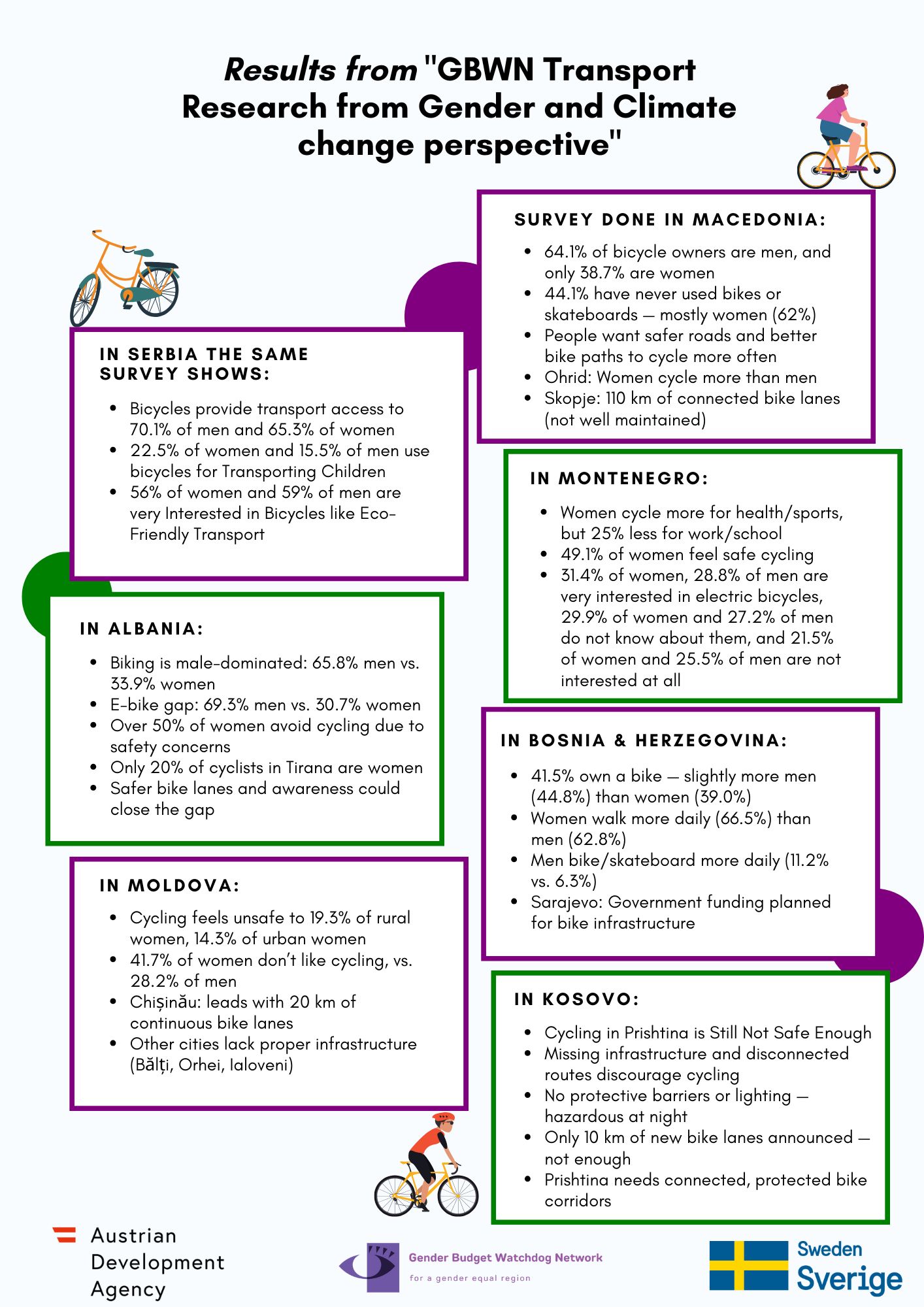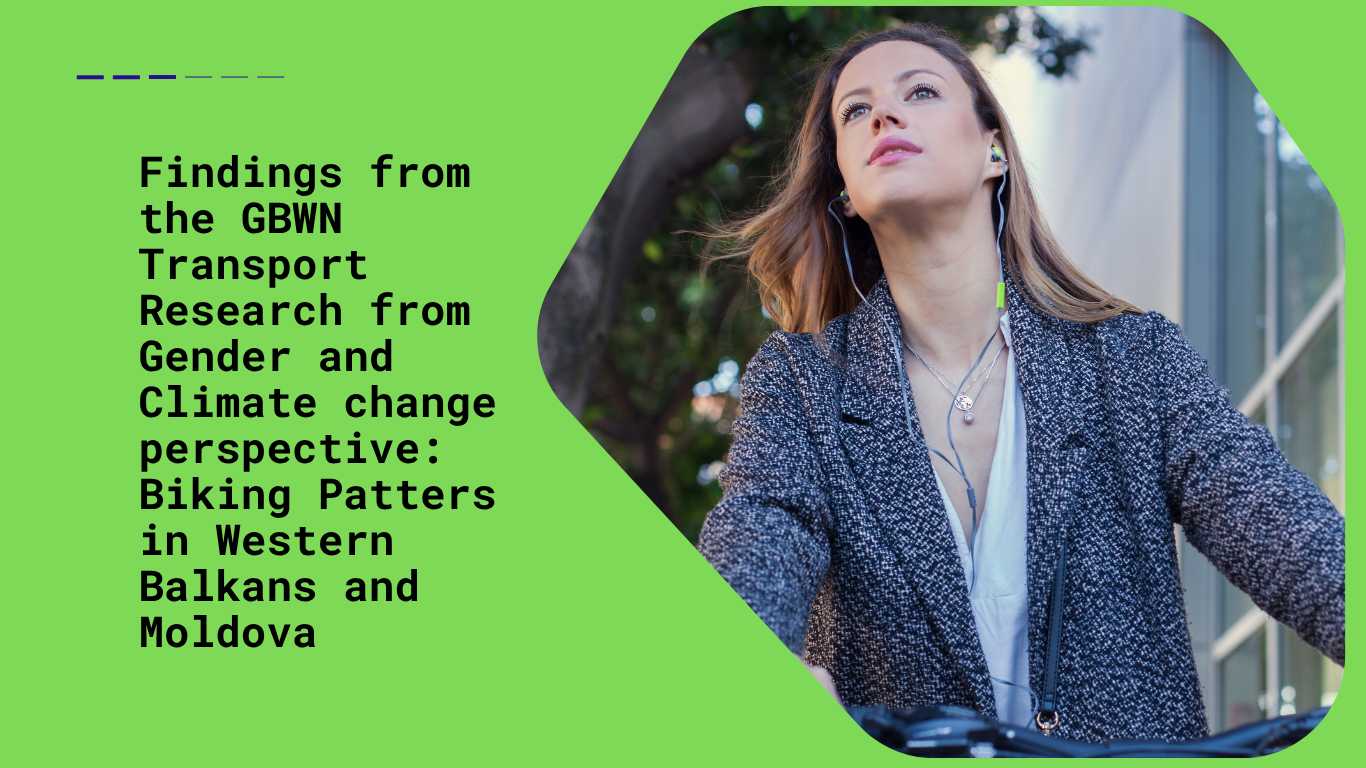Today, the 3rd of June, on World Bicycle Day, we celebrate the humble bicycle — a tool for clean transport, better health, and gender-inclusive mobility. But while the benefits of biking are universally acknowledged, the reality on the ground tells a different story: safety, accessibility, and gender equality are still major challenges in many countries across the Western Balkans and Eastern Europe. Let’s take a closer look at the data — and the stories behind it.
Who Cycles – And Who Doesn’t?
In North Macedonia, a recent survey found that:
-
64.1% of bicycle owners are men, while only 38.7% are women.
-
A striking 44.1% of people never use bicycles or skateboards. Among them, 62% are women.
The reasons are clear: lack of safety, poor infrastructure, and limited access to quality cycling lanes. In Skopje, although there are 110 km of bike lanes, many are poorly maintained, disconnected, and often unusable. Still, there are bright spots — in Ohrid, for example, women actually cycle more than men, defying regional trends.
In Serbia, bicycles serve as a crucial means of transportation for:
-
70.1% of men and 65.3% of women.
-
Women are more likely to use bikes for transporting children (22.5% vs. 15.5% of men).
-
Encouragingly, over 50% of both women and men see bicycles as an important eco-friendly transport solution.
Cycling for Health, But Not for Work
In Montenegro, women cycle more for health and sports, but far fewer use bicycles to get to work or school — with a gender gap of nearly 25%. Only 49.1% of women report feeling safe using a bike for transport.
Electric bicycles (e-bikes) are slowly gaining interest. 31.4% of women (vs. 28.8% of men) show strong interest in e-bikes, but around 30% still don’t know much about them — showing that awareness campaigns could make a difference.
Bosnia and Herzegovina: Walking More, Cycling Less
In BiH, 41.5% of people own a bicycle. Men are slightly more likely to be owners (44.8%) than women (39.0%). But when it comes to daily walking, women lead with 66.5% walking every day vs. 62.8% of men.
However, men are more likely to be daily cyclists or skateboarders — 11.2% of men compared to just 6.3% of women.
There’s reason for optimism: the Ministry of Transport in Sarajevo Canton has allocated funds to improve air quality through better cycling infrastructure.
Moldova: Unsafe Roads, Limited Progress
In Moldova, especially in rural areas, 19.3% of women report that cycling feels unsafe. Even in urban areas, 14.3% of women feel the same. That’s a major obstacle — especially when 41.7% of women say they simply “don’t like cycling,” often due to safety concerns, versus 28.2% of men.
The capital Chișinău is leading with 20 km of continuous bike lanes, but other cities like Bălți, Orhei, and Laloveni lag behind with limited or poorly implemented bike infrastructure.
Prishtina: A City Where Cyclists Still Feel Unsafe
Cycling in Prishtina – Still Not Safe Enough. While 10 km of new bike lanes have been announced, it’s nowhere near enough. Roads remain dangerous, lanes unprotected, and safety infrastructure like lights and signage is missing. Especially at night and in high-traffic zones, cyclists remain vulnerable.
What Prishtina Needs Now:
-
A city-wide bike-sharing scheme
-
Safe parking at public buildings and schools
-
Well-lit, connected bike lanes
-
Clear bike route maps and signage
-
Protected corridors that connect neighborhoods, parks, and workplaces
Albania: A Gender Gap on Two Wheels
Cycling in Albania remains heavily male-dominated:
-
Only 33.9% of women report using bicycles, compared to 65.8% of men.
-
With e-bikes, the gap widens: 69.3% of users are men, and just 30.7% are women.
-
Over 50% of women cite safety concerns as the reason they don’t cycle.
But there is hope. In Tirana, just 20% of cyclists are women — but with safer lanes, visible role models, and awareness efforts, that number could rise quickly.
What Can Be Done?
To truly celebrate World Bicycle Day, governments and cities must move beyond slogans and:
-
Build and maintain safe, continuous bike lanes
-
Ensure gender-sensitive planning, including lighting, safety, and child transport considerations
-
Launch awareness and training campaigns especially aimed at encouraging women and girls to cycle
-
Create bike-sharing programs, especially in underserved and low-income communities
-
Involve local CSOs and women’s groups in planning urban mobility policies
The data are part of the GBWN Transport Research from Gender and Climate change perspective done in all 7 countries and full reports will be available soon!



